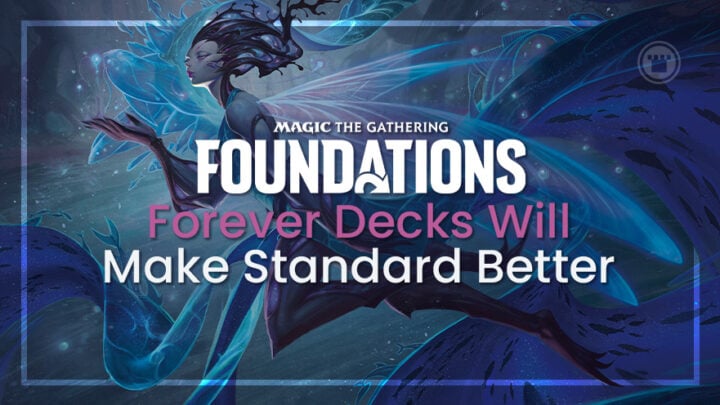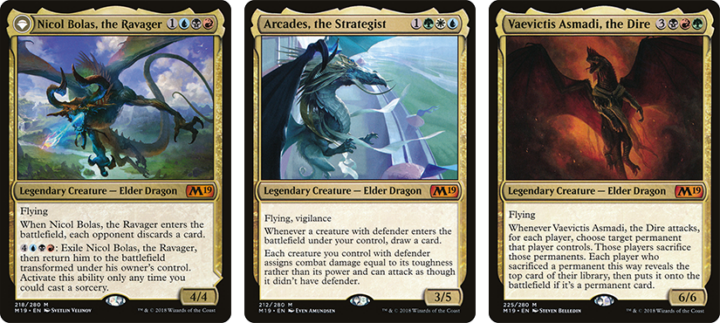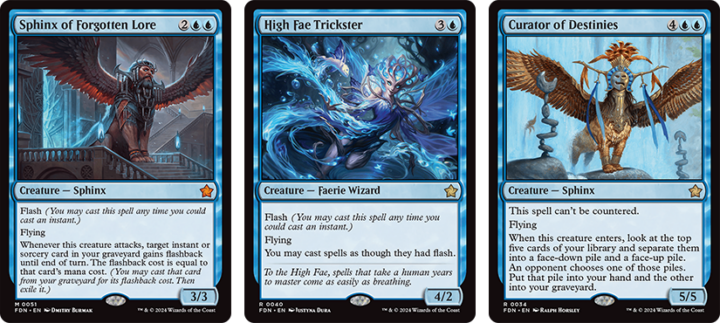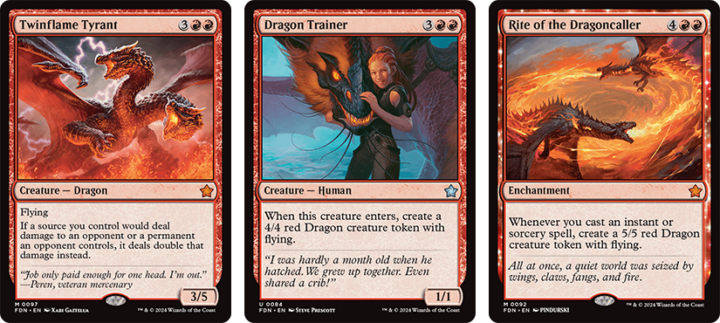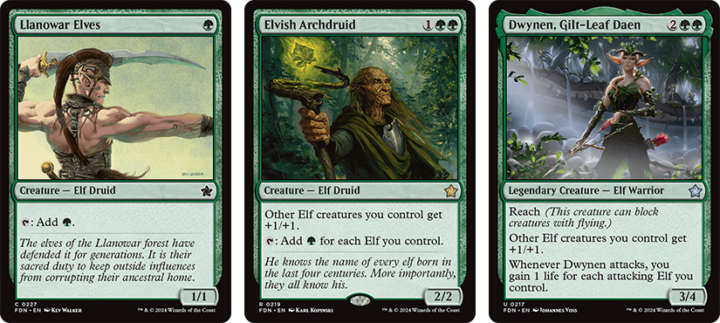Foundations is bringing Core Sets back to Magic (again), and so far it seems to have been a really good idea. I’ve seen many players celebrate that there’s some hard-to-define “classic” feeling to how the set plays, even extending to the parts of the set that aren’t reprints.
Part of that might be the power of branding, but Core Sets of the past were always recognizable for their focus on solid standalone card effects rather than specific themes and archetypes. It’s a kind of gameplay some players associate with Cube Draft… which I have also seen Foundations Limited compared to.
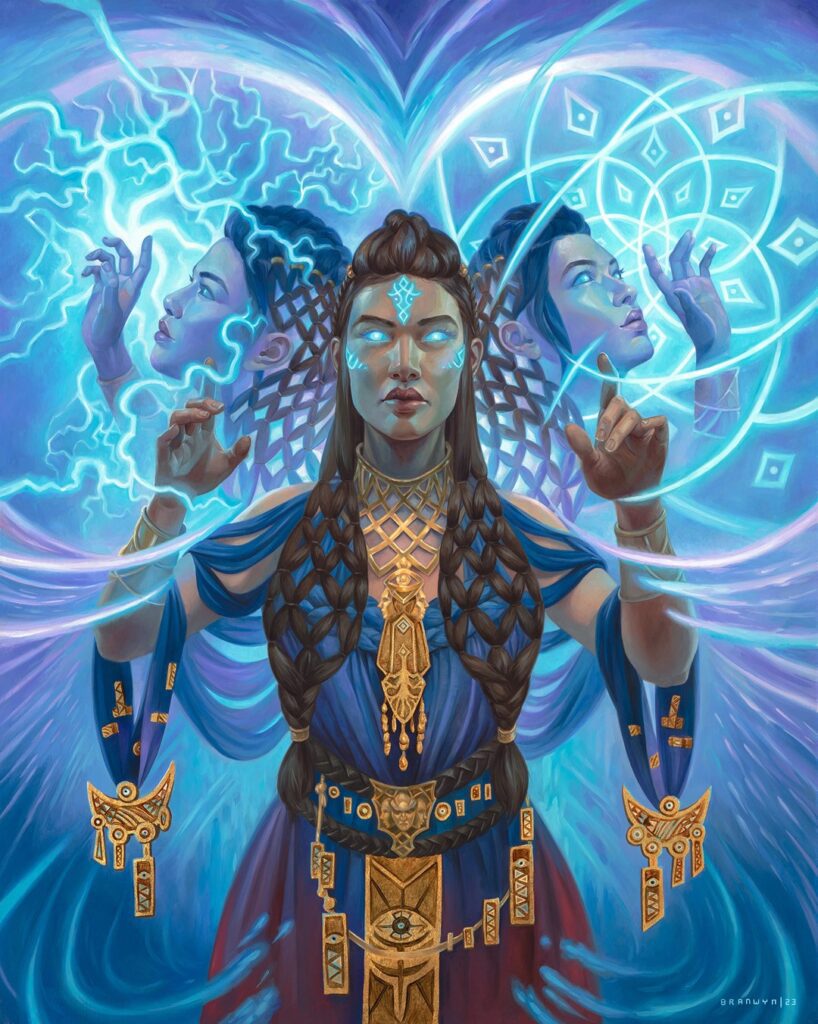
This “Core Set experience” is a breath of fresh air between sets with themes as pronounced as Duskmourn and Aetherdrift, but it’s just as refreshing to see how Foundations has tackled the historical downside of that design approach: the inability to support full Standard archetypes.
NOBODY LIKES A DILETTANTE
The decision to design Core Sets without unifying mechanical themes was not originally a decision at all. Until Magic 2010 these sets only contained reprints, selecting an all-star roster of existing cards which together represented the “current average” of Standard gameplay.
This grab-bag approach was very good for outlining the breadth of Magic’s mechanics and the basic contours of the color pie, but it was also clear that the cards only really “fit together” on this superficial level.
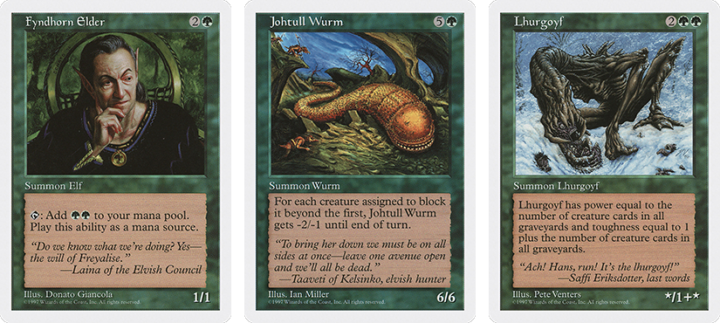
Besides color and type these 5th Edition creatures have almost nothing in common.
Even as later Core Sets began incorporating original card designs and set-wide flavor elements (like the Gatewatch backstories in Magic Origins, or Nicol Bolas and the Elder Dragons in M19) they upheld this expectation of “generic” mechanics.
This makes sense if you’re trying not to overwhelm new players with tons of rules in what was meant to be the beginner-friendly set. It even seems like the right call if you’re designing a semi-permanent “foundation” for Standard deck construction – at least on the surface. A mix of strong generic cards means the Core Set can provide equal support to all possible future Standard decks as they arise, which seems ideal.
But in practice, this just made them feel more like the Spare Parts Set. Without the benefits of synergy, most decks would only turn to the Core Set for generic removal spells or sideboard cards, making for low-value booster packs and weird Limited environments.
Even for the casual collectors and kitchen-table wizards, the “little bit of everything” approach feels destined to create a set where any player will be excited for roughly three cards and lukewarm on everything else – hardly a recipe for sales dominance.
THE CLASSICS (SHOULD) NEVER GO OUT OF FASHION
The lack of playable archetypes within Core Sets also made it basically impossible to construct any “rotation-proof” Standard decks using those cards – which Wizards may have thought was a good thing at the time, but in hindsight seems like a missed opportunity.
These products are meant to keep Standard accessible to new or infrequent players who aren’t keeping up with every set release. What better way to provide that sense of comfort than just printing some crowd-favorite archetypes entirely within the set – a “forever deck” that can be pulled out of the closet years from now, dusted off, and taken to FNM with no need for updates?
This is the biggest innovation Foundations makes on the classic Core Set formula, and it has been wonderfully realized. There seems to be at least one substantial archetype per color, many of which can overlap into two colors, offering some decent variety and chance for player expression.
The cards themselves are still relatively simple and generic, using only evergreen keywords and focused on the most fundamental resources and game actions. The difference is in the addition of payoffs and value engines that care about those fundamentals. It means white’s large portfolio of lifegain cards are signaling an actual strategy you can build around, not just “a thing white cards do”.
If you’re a fan of my Draft guides you might think that this is a lot of kerfuffle over what are more or less ordinary Limited archetypes, and you’d not be totally wrong. It’s the context of these synergy packages appearing within a non-rotating Core Set that makes them special, as well as the specific choice of cards with the traits to carry those archetypes not just in a Draft metagame, but in Standard.
I’m not saying that these “forever decks” built from only Foundations cards will be dominating tournaments at any point between now and 2029. In practice I’m sure that even most casual players will be flexing in a handful of “seasonal” cards from normal Standard sets to fill out their numbers and unlock a bit more exciting power. But that’s still a massive reversal of the previous paradigm, and one which bulldozes the most significant barrier keeping people from getting excited to try Constructed Magic.
OLD FAMILIAR FRIENDS
Foundations may be on a mission to update the classic pantheon of Core Set staples (even the reprints section heavily features cards from the past five years), but it is just as determined to present a familiar, coherent flavor identity for each color.
Even without a specific storyline, setting or characters to follow, it feels satisfying to see black fully focused on undead and demons, blue on ocean creatures and cerebral wizardry, or green on elven druids and beasts of the wild. These identities are as compelling and intuitive to new players as they ever were. For veterans this is basically the antithesis of the Universes Beyond vision for Magic, which may be another reason it was warmly received.
But when you’re looking for archetypes that have done the most to define an identity in the hearts of the playerbase, nothing beats creature types – and so the Foundations design team have made sure that typal themes will be a real option in Standard for years to come. We’ve got some OG favorites like elves, goblins and zombies, and some iconic modern typal decks like cats and angels in white and vampires in black.
Those seem to be the only decks Foundations blesses with dedicated support cards, but the vast majority of creatures in the set are from types also popular with deckbuilders – dinosaurs, elementals, pirates, etc. – and there’s a few universal “choose your type” enablers to give their diehard fans a rolling start!
Here I should also mention the biggest shock of the set for me – the decision to leave blue out of this typal party completely. While blue’s signature creature types are represented, the defining synergies of those creatures are with instants and sorcery spells, not each other.
I know blue’s color identity is often defined in opposition to creatures (or at least aggro decks), but it nevertheless has several of the most significant typal decks in Magic’s history! Why not celebrate the merfolk, faeries, wizards and spirits players with the same love extended to goblins and elves? There’s surely as many of them out there who might be tempted by the chance to play their beloved archetype in Standard stress-free.
That said, I am personally happy to see those slots used to install long-term support for Mono-U Tempo – a deck which I think makes the metagame healthier by existing the same way Red Burn does. So perhaps the ultimate complaint is just that even this massive set doesn’t have enough room to include every great Constructed playstyle from Magic’s history.
THE DECK THAT FEELS LIKE HOME
I don’t think there’s a single self-identified Magic player who doesn’t identify emotionally with a specific playstyle. Whether you associate it with a color combination, a commander choice, a past tournament deck, or even a certain Limited format, there’s a kind of deck and spell and gameplay which you’ll always be most excited for when the opportunity arises to play it.
I know that even if I was to take a long hiatus from Magic (and at times I have done so before), I would still be tempted if someone offered to lend me some durdly white midrange deck for the night. That is the main benefit I see being offered by these non-rotating Foundations archetypes.
This card game has existed for a shockingly long time and been enjoyed by millions upon millions of people, but engaging with even the most accessible Constructed format is a commitment that makes casual participation impossible. If Wizards have a way to relax those requirements, and pair it with the experience of a familiar, beloved playstyle, I believe Standard can recapture some of its prominence as the peoples’ format.

Tom’s fate was sealed in 7th grade when his friend lent him a pile of commons to play Magic. He quickly picked up Boros and Orzhov decks in Ravnica block and has remained a staunch white magician ever since. A fan of all Constructed formats, he enjoys studying the history of the tournament meta. He specializes in midrange decks, especially Death & Taxes and Martyr Proc. One day, he swears he will win an MCQ with Evershrike. Ask him how at @AWanderingBard, or watch him stream Magic at twitch.tv/TheWanderingBard.

